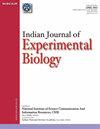Green synthesis, characterization and anticancer activity of fungal asparaginase from Aspergillus terreus conjugated on MgO-ZnO nanocomposite against liver cancer cells
IF 0.7
4区 生物学
Q4 BIOLOGY
引用次数: 0
Abstract
L-Asparaginase exists as an effective chemotherapeutic drug for various cancer cell types. However, the L-asparaginase enzyme in its free state is unstable and has reduced half-life period with numerous side effects. Here, as a green synthesis approach, we have tried a nanocarrier to reduce its side effects and thereby the environmental pollution and toxicity. We used leaf extract of Mesosphaerum suaveolens (L.) Kuntze, commonly called Pignut, Wild spikenard or Horsehound, to produce a Mg-ZnO nanocomposite, which has antitumor activity by arresting the cell cycle of tumour cells. To the synthesized nanocomposite, extracted L-asparaginase enzyme from Aspergillus terreus was impregnated. The presence of ZnO helps to preserve the biological activity of immobilized L-asparaginase along with MgO making the nanocarrier biocompatible and biodegradable. This helps in increasing the stability and anticancer property of the L-asparaginase. The enzyme-impregnated nanobiocomposite was characterized using UV-Vis spectroscopy which ensured the existence of the Asp-Mg-ZnO in the nanobiocomposite. The presence of functional group and the crystallinity nature of the nanobiocomposite were studied using FT-IR and XRD, respectively. The morphological structure and elemental composition of the nanobiocomposite were determined using the SEM-EDAX. The anticancer activity of the synthesized Asp-Mg-ZnO nanobiocomposite was determined using the MTT assay, which helped to determine the viability and proliferation capacity of the cancer cells.氧化镁-氧化锌纳米复合材料结合地曲霉真菌天冬酰胺酶的绿色合成、表征及抗癌活性研究
l -天冬酰胺酶作为一种有效的化疗药物存在于各种类型的癌细胞中。然而,游离状态下的l -天冬酰胺酶不稳定,半衰期缩短,副作用多。在这里,作为一种绿色合成方法,我们尝试了一种纳米载体来减少其副作用,从而减少对环境的污染和毒性。本研究以中叶植物(Mesosphaerum suaveolens, L.)的叶提取物为原料。Kuntze,通常被称为Pignut, Wild spikenard或horhound,生产Mg-ZnO纳米复合材料,通过阻止肿瘤细胞的细胞周期具有抗肿瘤活性。对从土曲霉中提取的l -天冬酰胺酶进行浸渍制备纳米复合材料。氧化锌和氧化镁的存在有助于保持固定化l -天冬酰胺酶的生物活性,使纳米载体具有生物相容性和可生物降解性。这有助于增加l -天冬酰胺酶的稳定性和抗癌特性。利用紫外可见光谱对酶浸纳米复合材料进行了表征,确定了Asp-Mg-ZnO在纳米复合材料中存在。利用红外光谱(FT-IR)和x射线衍射(XRD)对纳米生物复合材料的结晶性和官能团的存在进行了表征。利用SEM-EDAX测定了纳米生物复合材料的形态结构和元素组成。采用MTT法测定合成的Asp-Mg-ZnO纳米生物复合材料的抗癌活性,从而确定其癌细胞的生存能力和增殖能力。
本文章由计算机程序翻译,如有差异,请以英文原文为准。
求助全文
约1分钟内获得全文
求助全文
来源期刊
CiteScore
1.57
自引率
33.30%
发文量
84
审稿时长
6 months
期刊介绍:
This journal, started in 1963, publishes full papers, notes and reviews in cell biology, molecular biology, genetic engineering, endocrinology, reproductive biology, immunology, developmental biology, comparative physiology, radiation biology, chronobiology, microbiology, pharmacology, toxicology and other biological fields including instrumentation and methodology. The papers having experimental design involving alteration and/or manipulation in biological system(s) providing insight into their functioning are considered for publication. Studies involving higher animals, human beings and of clinical nature are not encouraged for publication in the journal.

 求助内容:
求助内容: 应助结果提醒方式:
应助结果提醒方式:


